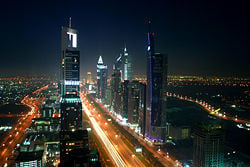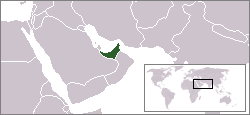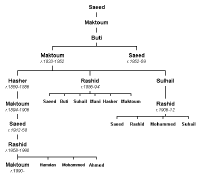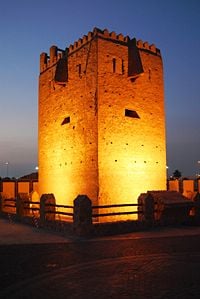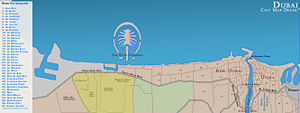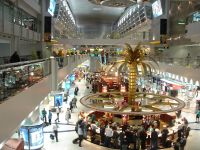Dubai
| Emirate of Dubai إمارة دبيّ |
|||
| Dubai's nightime skyline | |||
|
|||
| Coordinates: 25°16′N 55°20′E | |||
|---|---|---|---|
| Emirate | Dubai | ||
| Government | |||
| - Emir | Sheikh Mohammed bin Rashid Al Maktoum | ||
| Area [1] | |||
| - Metro | 4,114 km² (1,588.4 sq mi) | ||
| Population (2006)[2][3] | |||
| - Density | 345.65/km² (895.2/sq mi) | ||
| - Metro | 1,492,000 | ||
| Time zone | Dubai Standard Time (UTC+4) | ||
| Website: Dubai Emirate Dubai Municipality | |||
Dubai (in Arabic: دبيّ, Dubayy, /dʊ'baɪ/ in English) can either refer to one of the seven emirates that constitute the United Arab Emirates (UAE) in the eastern Arabian Peninsula, or that emirate's main city, sometimes called "Dubai city" to distinguish it from the emirate.
The modern emirate of Dubai was created with the formation of the United Arab Emirates in 1971. However, written accounts documenting the existence of the city have existed at least 150 years prior to the formation of the UAE. Dubai shares legal, political, military and economic functions with the other emirates within a federal framework, although each emirate has jurisdiction over some functions such as civic law enforcement and provision and upkeep of local facilities. Dubai has the largest population and is the second largest emirate by area, after Abu Dhabi.[4] With Abu Dhabi, it is one of only two emirates to possess veto power over critical matters of national importance in the UAE.[5] Dubai has been ruled by the Al Maktoum dynasty since 1833. The emirates' current ruler, Mohammed bin Rashid Al Maktoum, is also the Prime Minister and Vice President of the UAE.
Revenues from petroleum and natural gas contribute less than 6% (2006)[6] of Dubai's US$ 37 billion economy (2005).[7] A majority of the emirate's revenues are from the Jebel Ali free zone authority (JAFZA)[8] and, increasingly, from tourism and other service-oriented businesses. Dubai has attracted world-wide attention through innovative real estate projects [9] and sports events. This increased attention, coinciding with its emergence as a world business hub, has also highlighted human rights issues concerning its largely foreign workforce.
History
Very little is known about pre-Islamic culture in the south-east Arabian peninsula, except that many ancient towns in the area were trading centres between the Eastern and Western worlds. The remnants of an ancient mangrove swamp, dated at 7,000 years, were discovered during the construction of the Sheikh Zayed Road. The area had been covered with sand about 5,000 years ago as the coastline retreated inland, becoming a part of the city's present coastline.[10] Prior to Islam, the people in this region were idol worshippers, who worshiped Bajir (or Bajar).[11] The Byzantine and Sassanian empires constituted the great powers of the period, with the Sassanians controlling much of the region. After the spread of Islam in the region, the Umayyad Caliph, of the eastern Islamic world, invaded south-east Arabia and drove out the Sassanians. Excavations undertaken by the Dubai Museum in the region of Al-Jumayra (Jumeirah) indicate the existence of several artifacts from the Umayyad period.[12] The earliest recorded mention of Dubai is in 1095, in the "Book of Geography" by the Spanish-Arab geographer Abu Abdullah al-Bakri. The Venetian pearl merchant Gaspero Balbi visited the area in 1580 and mentioned Dubai (Dibei) for its pearling industry.[12] Documented records of the town of Dubai exist only after 1799.[13]
In the early 19th century, the Al Abu Falasa clan (House of Al-Falasi) of Bani Yas clan established Dubai, which remained a dependent of Abu Dhabi until 1833.[14] On 8 January 1820, the sheikh of Dubai and other sheikhs in the region signed the "General Maritime Peace Treaty" with the British government.[10] However, in 1833, the Al Maktoum dynasty (also descendants of the House of Al-Falasi) of the Bani Yas tribe left the settlement of Abu Dhabi and took over Dubai from the Abu Fasala clan without resistance.[14] Dubai came under the protection of the United Kingdom by the "Exclusive Agreement" of 1892, with the latter agreeing to protect Dubai against any attacks from the Ottoman Empire.[14] Two catastrophes struck the town during the mid 1800s. First, in 1841, a smallpox epidemic broke out in the Bur Dubai locality, forcing residents to relocate east to Deira. Then, in 1894, fire swept through Deira, burning down most homes.[15] However, the town's geographical location continued to attract traders and merchants from around the region. The emir of Dubai was keen to attract foreign traders and lowered trade tax brackets, which lured traders away from Sharjah and Bandar Lengeh, which were the region's main trade hubs at the time.[16][15]
Dubai's geographical proximity to India made it an important location. The town of Dubai was an important port of call for foreign tradesmen, chiefly those from India, many of whom eventually settled in the town. Dubai was known for its pearl exports until the 1930s. However, Dubai's pearling industry was damaged irreparably by the events of the First World War, and later on by the Great Depression in the late 1920s. Consequently, the city witnessed a mass migration of people to other parts of the Persian Gulf.[10] Since its inception, Dubai was constantly at odds with Abu Dhabi. In 1947, a border dispute between Dubai and Abu Dhabi on the northern sector of their mutual border, escalated into war between the two states.[17] Arbitration by the British and the creation of a buffer frontier running south eastwards from the coast at Ras Hasian resulted in a temporary cessation of hostilities.[18] However, border disputes between the emirates continued even after the formation of the UAE; it was only in 1979 that a formal compromise was reached that ended hostilities and border disputes between the two states.[19] Electricity, telephone services and an airport were established in Dubai in the 1950s, when the British moved their local administrative offices from Sharjah to Dubai.[20] The town joined the newly independent country of Qatar to set up a new monetary unit, the Qatar/Dubai Riyal, after the deflation of the Gulf rupee.[13] Oil was discovered in Dubai the same year, after which the town granted concessions to international oil companies. The discovery of oil led to a massive influx of foreign workers, mainly Indians and Pakistanis, into the city. As a result, the population of the city from 1968 to 1975 grew by over 300%, by some estimates.[21]
On 2 December 1971 Dubai, together with Abu Dhabi and five other emirates, formed the United Arab Emirates after former protector Britain left the Persian Gulf in 1971.[22] In 1973, Dubai joined the other emirates to adopt a uniform currency: the UAE dirham. In the 1970s, Dubai continued to grow from revenues generated from oil and trade even as the city saw an influx of Lebanese immigrants fleeing the civil war in Lebanon.[23] The Jebel Ali Free Zone, comprising the Jebel Ali port (reputedly the world's largest man made port) was established in 1979, which provided foreign companies unrestricted import of labour and export capital.[24]
The Persian Gulf War of 1990 had a huge impact on the city. Economically, Dubai banks experienced a massive withdrawal of funds due to uncertain political conditions in the region. During the course of the 1990s, however, many foreign trading communities — first from Kuwait, during the Persian Gulf War, and later from Bahrain, during the Shia unrest, moved their businesses to Dubai.[16] Dubai provided refueling bases to allied forces at the Jebel Ali free zone during the Persian Gulf war, and again, during the 2003 Invasion of Iraq. Large increases in oil prices after the Persian Gulf war encouraged Dubai to continue to focus on free trade and tourism.[25] The success of the Jebel Ali free zone allowed the city to replicate its model to develop clusters of new free zones, including Dubai Internet City, Dubai Media City and Dubai Maritime City. The construction of Burj Al Arab, the world's tallest freestanding hotel, as well as the creation of new residential developments, were used to market Dubai for purposes of tourism. Since 2002, the city has seen an increase in private real estate investment in recreating Dubai's skyline[25] with such projects as The Palm Islands, The World Islands and Burj Dubai. However, robust economic growth in recent years has been accompanied by rising inflation rates (at 6.2% as of 2006 when measured against Consumer Price Index) which is attributed in part due to the near doubling of commercial and residential rental costs, resulting in a substantial increase in the cost of living for residents.[26]
Geography
| |||||||||||||||||||||||||||||||||||||||||||||||||||||||||||||||||||||||||||||||||||||||||||||||
| |||||||||||||||||||||||||||||||||||||||||||||||||||||||||||||||||||||||||||||||||||||||||||||||
Dubai is situated on the Persian Gulf coast of the United Arab Emirates and is roughly at sea level (16 m above). The emirate of Dubai shares borders with Abu Dhabi in the south, Sharjah in the northeast, and the Sultanate of Oman in the southeast. Hatta, a minor exclave of the emirate, is surrounded on three sides by Oman and by the emirates of Ajman (in the west) and Ras Al Khaimah (in the north). The Persian Gulf borders the western coast of the emirate. Dubai is positioned at and covers an area of 4,114 km² (1,588 mi²).
Dubai lies directly within the Arabian Desert. However, the topography of Dubai is significantly different from that of the southern portion of the UAE in that much of Dubai's landscape is highlighted by sandy desert patterns, while gravel deserts dominate much of the southern region of the country.[28] The sand consists mostly of crushed shell and coral and is fine, clean and white. East of the city, the salt-crusted coastal plans, known as sabkha, give way to a north-south running line of dunes. Farther east, the dunes grow larger and are tinged red with iron oxide.[21] The flat sandy desert gives way to the Western Hajar Mountains, which run alongside Dubai's border with Oman at Hatta. The Western Hajar chain has an arid, jagged and shattered landscape, whose mountains rise to about 1,300 meters in some places. Dubai has no natural river bodies or oases; however, Dubai does have a natural inlet, Dubai Creek, which has been dredged to make it deep enough for large vessels to pass through. Dubai also has multiple gorges and waterholes which dot the base of the Western Al Hajar mountains. A vast sea of sand dunes cover much of southern Dubai, which eventually lead into the desert known as The Empty Quarter. Seismically, Dubai is in a very stable zone — the nearest seismic fault line, the Zargos Fault, is 120 km from the UAE and is unlikely to have any seismic impact on Dubai.[29] Experts also predict that the possibility of a tsunami in the region is also minimal because the Persian Gulf waters are not deep enough to trigger a tsunami.[29]
The sandy desert surrounding the city supports wild grasses and occasional date palm trees. Desert hyacinths grow in the sabkha plans east of the city, while acacia and ghaf trees grow in the flat plains within the proximity of the Western Al Hajar mountains. Several indigenous trees such as the date palm and neem as well as imported trees like the eucalypts grow in Dubai's natural parks. The houbara bustard, striped hyena, caracal, desert fox, falcon and Arabian oryx are common in Dubai's desert. Dubai is on the migration path between Europe, Asia and Africa, and more than 320 migratory birds pass through the emirate in spring and autumn. The waters of Dubai are home to more than 300 species of fish, including the hammour.
Dubai Creek runs northeast-southwest through the city. The eastern section of the city forms the locality of Deira and is flanked by the emirate of Sharjah in the east and the town of Al Aweer in the south. The Dubai International Airport is located south of Deira, while the Palm Deira is located north of Deira in the Persian Gulf. The western section forms the locality of Bur Dubai. Much of Dubai's real estate boom has been concentrated to the west of this region, on the Jumeirah coastal belt and along Sheikh Zayed Road (E11). Port Rashid, Jebel Ali, Burj Al Arab, the Palm Jumeirah and theme based free zone clusters such as Business Bay are all located in this section. Sheikh Zayed Road and Emirates Road (E311) are the main arteries of Dubai; and run roughly parallel to each other in the western section of the city, before eventually diverging sharply near Jumeirah. The eastern and western sections of the city are connected by Al Maktoum Bridge, Al Garhoud Bridge, Al Shindagha Tunnel, Business Bay Crossing and Floating Bridge.
Dubai has a hot and, at times, humid climate with many months recording temperatures of over 40°C (104°F) (refer to accompanying table for recorded mean minimum and maximum temperatures during the year). Rainfall is generally light, with a mean of about 100 mm per year; precipitation is usually centered around January, February and March[30] The mean humidity in Dubai is about 60%.
Demographics
| Year | Population |
| 18221 | 1,200 [31] |
| 19001 | 10,000 [32] |
| 19301 | 20,000 [33] |
| 19401 | 38,000 [31] |
| 19541 | 20,000 [31] |
| 19601 | 40,000 [34] |
| 1968 | 58,971 [35] |
| 1975 | 183,000 [36] |
| 1985 | 370,800 [37] |
| 1995 | 674,000 [37] |
| 2005 | 1,204,000 |
| 1 The town of Dubai first conducted a census in 1968. All population figures in this table that prior to 1968 are estimates obtained from various sources. | |
According to the census conducted by the Statistics Center of Dubai, the population of the emirate was 1,422,000 as of 2006, which included 1,073,000 males and 349,000 females.[38] As of 1998, 17% of the population of the emirate was made up of UAE nationals. Approximately 85% of the expatriate population (and 71% of the emirate's total population) was Asian, chiefly Indian (51%), Pakistani (16%), Bangladeshi (9%) and Filipino (3%).[39] About 3% of the total population of Dubai was categorized as "Western." A quarter of the population however reportedly traces their origins to neighboring Iran.[40] In addition, 16% of the population (or 288,000 persons) lived in collective labour accommodation were not identified by ethnicity or nationality, but were thought to be primarily Asian.[41] The median age in the emirate was about 27 years. The crude birth rate, as of 2005, was 13.6%, while the crude death rate was about 1%.[42]
Although Arabic is the official language of Dubai, Persian, Malayalam, English, Hindi, Urdu, Bengali, and Tagalog are widely spoken. Article 7 of the UAE's Provisional Constitution declares Islam the official state religion of the UAE. The government subsidizes almost 95 percent of Sunni mosques and employs all Sunni imams; approximately 5 percent of Sunni mosques are entirely private, and several large mosques have large private endowments.[43]
Dubai has large expatriate Hindu, Sikh, and Christian communities. Non-Muslim groups can own their own houses of worship, where they can practice their religion freely, by requesting a land grant and permission to build a compound. Groups that do not have their own buildings must use the facilities of other religious organizations or worship in private homes. Non-Muslim religious groups are permitted to openly advertise group functions; however, proselytizing or distributing religious literature is strictly prohibited under penalty of criminal prosecution, imprisonment, and deportation for engaging in behavior offensive to Islam.[43]
Economy
Dubai's gross domestic product as of 2006 was US$46 billion. Although Dubai's economy was built on the back of the oil industry,[44] revenues from oil and natural gas currently account for less than 6% of the emirate's revenues.[6] It is estimated that Dubai produces 240,000 barrels of oil a day and substantial quantities of gas from offshore fields. The emirate's share in UAE's gas revenues is about 2%. Dubai's oil reserves have diminished significantly and are expected to be exhausted in 20 years.[45]
Historically, Dubai and its twin across the Dubai creek, Deira (independent of Dubai City at that time), became important ports of call for Western manufacturers. Most of the new city's banking and financial centres were headquartered in the port area. Dubai maintained its importance as a trade route through the 1970s and 1980s. The city of Dubai has a free trade in gold and until the 1990s was the hub of a "brisk smuggling trade" of gold ingots to India, where gold import was restricted.
Dubai is an important tourist destination and its port, Jebel Ali, constructed in the 1970s, has the largest man-made harbor in the world. Dubai is also increasingly developing as a hub for service industries such as IT and finance, with the establishment of a new Dubai International Financial Centre (DIFC). The government has set up industry-specific free zones throughout the city. Dubai Internet City, combined with Dubai Media City as part of TECOM (Dubai Technology, Electronic Commerce and Media Free Zone Authority) is one such enclave whose members include IT firms such as EMC Corporation, Oracle Corporation, Microsoft, and IBM, and media organisations such as MBC, CNN, Reuters and AP.
The Dubai Financial Market (DFM) was established in March 2000 as a secondary market for trading securities and bonds, both local and foreign. As of Q4 2006, its trading volume stood at about 400 billion shares worth US$ 95 billion. The DFM had a market capitalization of about US$ 87 billion.[42]
The government's decision to diversify from a trade-based, but oil-reliant, economy to one that is service and tourism-oriented has made real estate more valuable, resulting in the property appreciation from 2004–2006. Large scale real estate development projects have led to the construction of some of the tallest skyscrapers and largest projects in the world such as the Emirates Towers, the Palm Islands and the world's tallest, and most expensive, hotel the Burj Al Arab.[46] As of July 2007, the Burj Dubai became the world's tallest structure and is expected to be taller by several hundred feet, once construction is complete. Construction should finish in late 2008 and the building occupied by September of 2009. There will be an estimated 164 floors, the top floor at 624.1 meters, or 2,058 feet. Including the antennae and spire the total height of the Burj Dubai will be an estimated 818 meters, or 2,684 feet. [47]
The Dubai government maintains policies that are friendly to foreigners. Some years back, it has decided to do away with all personal, corporate and sales taxes. This has caused the phenomenal influx of businesses and foreign workers into the emirate. Consequently, real estate boomed. Moreover, old laws of the emirate prohibited foreigners to own properties there. This has changed in 2002 when the current ruler allowed foreigners to buy and invest in properties in Dubai.
Human rights and labour
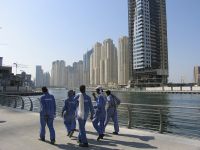
Dubai has over 250,000 foreign laborers, many of whom live in conditions described by Human Rights Watch as being "less than human." [48][49] NPR reports that workers "typically live eight to a room, sending home a portion of their salary to their families, whom they don't see for years at a time." The BBC has reported that "local newspapers often carry stories of construction workers allegedly not being paid for months on end. They are not allowed to move jobs and if they leave the country to go home they will almost certainly lose the money they say they are owed.[50] In September 2005, the Minister of Labour ordered one company to pay unpaid salaries within 24 hours after workers protested, and published the name of the offending company.[51] In December 2005, the Indian consulate in Dubai submitted a report to the Government of India detailing labor problems faced by Indian expatriates in the emirate. The report highlighted delayed payment of wages, substitution of employment contracts, premature termination of services and excessive working hours as being some of the challenges faced by Indian workers in the city. On 21 March 2006, workers at the construction site of Burj Dubai, upset over bus timings and working conditions, rioted damaging cars, offices, computers, and construction tools.[52][53][54] The city's discriminatory legal system and unequal treatment of foreigners has been brought to light by its alleged attempts to cover up information on the rape of Alexandre Robert, a 15 year old French-Swiss national, by three locals, one of whom HIV status was hidden by the authorities for several months [55] and by the recent mass imprisonment of migrant laborers, most of whom were from India, on account of their protests against poor wages and living conditions.[56]
Prostitution, though illegal by law, is conspicuously present in the emirate because of an economy that is largely based on tourism and trade. Research conducted by the American Center for International Policy Studies (AMCIPS) found that Russian and Ethiopian women are the most common prostitutes, as well as women from some African countries, while Indian prostitutes are part of a well organized trans-Oceanic prostitution network.[57] A 2007 PBS documentary entitled Dubai: Night Secrets reported that prostitution in clubs is tolerated by authorities and many foreign women work there without being coerced, attracted by the money.[58] [59] [60] [61] [62].
Transport
The main road that connects one side of Dubai with the other is Sheikh Zayed Road. In July 2007, Salik road toll collection points were installed on the Sheikh Zayed road and on Al Garhoud bridge, which emphasizes the system’s congestion management objectives as well as the choice of technology for the toll system. The new system utilizes the latest technology to achieve free flow operation with no toll booths, no toll collectors, and no impact to traffic flow, allowing vehicles to move freely through the tolling point at highway speeds. Each time one passes through a Salik tolling point, the toll of AED 4 will be deducted from her or his prepaid toll account using Radio Frequency Identification (RFID) technology.
Dubai International Airport (IATA: DXB), the hub for Emirates Airlines, services the city of Dubai and other emirates in the country. The airport served a total of over 28 million passengers and over 230,000 flights in 2006.[63] The Dubai International Airport ranks 17th among international airports for total cargo traffic in 2006.[64] A third terminal is currently under construction and is due to open in 2007. The new terminal will be dedicated to Emirates Airline and will fully support the new Airbus A380. The development of Dubai World Central International Airport, currently under construction in Jebel Ali, was announced in 2004. The first phase is expected to be completed by 2008, and once operational the new airport will host foreign airlines. Emirates (both the passenger and cargo operations) will remain in Dubai International Airport.[65]
Dubai has a large bus system that services 69 routes and transported over about 90 million people in 2006. The (RTA) announced in 2006 that an additional 620 new buses will be added to its fleet of 170 double decker buses.[66] Although the main mode of transportation in Dubai is by private vehicle, Dubai also has an extensive taxi system.
A $3.89 billion Dubai Metro project is under construction for the emirate. The Metro system is expected to be partially operational by 2009 and fully operational by 2012. The metro will comprise two lines: the Green Line from Rashidiya to the main city center and the Red Line from the airport to Jebel Ali. The Dubai Metro (Green and Blue Lines) will have 70 kilometers of track and 43 stations, 33 above ground and ten underground.[67] One of the more traditional methods of getting across Bur Dubai to Deira is through abras, small boats that ferry passengers across the Dubai Creek, between abra stations in Bastakiya and Bani Yas road.
Education
The school system in Dubai does not differ from that of the United Arab Emirates. As of 2006, there are 88 public schools run by the Ministry of Education that serve Emiratis and expatriate Arabs as well as 132 private schools.[38] The medium of instruction in public schools is Arabic with emphasis on English as a second language, while most of the private schools use English as their medium of instruction. Most private schools cater to one or more expatriate communities. Delhi Private School, Our Own English High School, the Dubai Modern High School, and the Indian High School, Dubai offer either a CBSE or an ICSE Indian syllabus. Similarly, there are also several reputable Pakistani schools offering FBISE curriculum for expatriate children. Dubai English Speaking School, Jumeirah Primary School, Jebel Ali Primary School, the Cambridge High School (or Cambridge International School), Jumeirah English Speaking School, King's School and the Horizon School all offer British primary education up to the age of eleven. Dubai British School, Dubai College, English College Dubai, Jumeirah College and St. Mary's Catholic High School are all British eleven-to-eighteen secondary schools which offer GCSE and A-Levels. Emirates International School provides full student education up to the age of 18, this is an International school and offers IGCSE and the IB program. Wellington International School, which caters education from 4-18, offers IGCSE and A-Levels. Deira International School also offers the IB program including the IGCSE program.
The Ministry of Education of the United Arab Emirates is responsible for school's accreditation. The Dubai Education Council was established in July 2005 to develop the education sector in Dubai.[68] The Knowledge and Human Development Authority (KHDA) was established in 2006 to develop education and human resource sectors in Dubai, and license educational institutes.[69]
Approximately 10% of the population has university or postgraduate degrees. Many expatriates tend to send their children back to their home country or to Western countries for university education and even to India for technology studies. However, a sizable number of foreign accredited universities have been set up in the city over the last ten years. Some of these universities include the Birla Institute of Technology and Science, Pilani (BITS Pilani), American University in Dubai (AUD), the American College of Dubai, SP Jain Center Of Management,University of Wollongong in Dubai and Institute of Management Technology, Dubai. In 2004, the Dubai School of Government in collaboration with Harvard University's John F. Kennedy School of Government and Harvard Medical School Dubai Center (HMSDC) were established in Dubai. Even though Dubai has plans to increase more accredited colleges, they continue to send 90% of all potential secondary school students to India for a stronger technological education. Generally, they believe that India's increasingly technologically advanced education programs will bring forth strong economic growth in Dubai.
Admission to any of these schools is based on the institution’s respective policies. They differ in deadlines of submission of applications, admission procedures and tuition and matriculation fees. It is best to contact the school or institution to inquire about its own procedures.
Media
Dubai has a well established network of print, radio, television and electronic media to cater to the needs of the city. Dubai has courted many media and technology companies which has allowed the city to become a major media hub. The city has over half a million telephone and facsimile subscribers. There are about 180,000 internet subscribers in the city. While there are multiple international channels available to residents through cable, satellite and radio connections, local channels are available from the Arabian Radio Network and Dubai Media Incorporated.
Many international news agencies and network news channels operated out of the Dubai Media City and Dubai Internet City.
Reuters, APTN, MBC, CNBC Arabiya, Bloomberg L.P., BMG, Showtime Arabia, BBC and CNN have all set up regional offices in the area. There are also a number of local publishing companies, including Explorer Publishing, ITP and Motivate. Etisalat currently is the leading internet provider in the emirate. Du (telco), a new telecommunication company, will also provide internet services in the emirate. Internet content is strongly regulated for pornography and for content that might be considered offensive in an Islamic state. In addition to that services such as Skype have also been blocked by Etisalat. Emirates Media and Internet (a division of Etisalat) notes that as of 2002, 76% of internet users are male. About 60% of internet users were Asian, while 25% of users were Arab. Dubai enacted an Electronic Transactions and Commerce Law in 2002 which deals with digital signatures and electronic registers. It prohibits Internet Service Providers (ISPs) from disclosing information gathered in providing services. The penal code also contains some provisions; however it does not address cyber crime or data protection.[70]
See also
- Dubai Festival City
- Dubai Financial Market
- Dubai Healthcare City
- Tourism in Dubai
- Travel guide to Dubai from Wikitravel
Notes
- ↑ Area of "Dubai emirate", includes artificial islands.
- ↑ "Statistics Centre: Dubai emirate population is 1,422,000," UAE Interact: UAE Ministry Of Information and Culture, 2006-08-30
- ↑ Density of "Dubai emirate"
- ↑ United Arab Emirates: metropolitan areas
- ↑ The Government and Politics of the Middle East and North Africa. D Long, B Reich. p.157
- ↑ 6.0 6.1 Oil share dips in Dubai GDP AMEInfo (9 June 2007). Retrieved on 15 October 2007.
- ↑ Dubai economy set to treble by 2015 ArabianBusiness.com (3 February 2007). Retrieved on 15 October 2007.
- ↑ .:: Dubai Trade ::., Dubai Trade
- ↑ Dubai map with upcoming freehold developments
- ↑ 10.0 10.1 10.2 History and Traditions of the UAE
- ↑ History and Background of the UAE
- ↑ 12.0 12.1 The Coming of Islam and the Islamic Period in the UAE. King, Geoffrey R.
- ↑ 13.0 13.1 Economic and Environmental Impacts of tourism on Dubai and Hawaii. McEachern, Nadeau, et al
- ↑ 14.0 14.1 14.2 Country Profile: United Arab Emirates. United States Library of Congress
- ↑ 15.0 15.1 [http://www.alshindagah.com/september99/architecture.htm Modernity and tradition in Dubai architecture. Karim, Luiza
- ↑ 16.0 16.1 THE EMIRATES OF ABU DHABI AND DUBAI:CONTRASTING ROLES IN THE INTERNATIONAL SYSTEM. Davidson, Christopher. March 2007
- ↑ The UAE: Internal Boundaries And The Boundary With Oman. Archived Editions. Walker, J.
- ↑ The Middle East and North Africa. Schofield, C. p 175
- ↑ Dubai. Carter, T and Dunston, L. Lonely Planet Publications
- ↑ Dubai City. Melamid, Alexander. Jul 1989
- ↑ 21.0 21.1 Historic population statistics
- ↑ "Six Persian Gulf Emirates Agree to a Federation." New York Times. Jul 19, 1971. pg. 4
- ↑ "Beirut Showing Signs of Recovery From Wounds of War." New York Times. May 26, 1977. pg.2
- ↑ The United Arab Emirates: Economic Vibrancy and US Interests. Asian Affairs. Peterson, JE. July 2002, Vol 34, Issue 2.
- ↑ 25.0 25.1 Dubai Focus
- ↑ Robust growth poses threat of inflation to high-flying Dubai. Kuwait Times. Mar. 8, 2007
- ↑ OnlineWeather Portal. UAEInteract.com. Retrieved 5/1/2007
- ↑ Environmental Development and Protection in the UAE. Aspinall, Simon
- ↑ 29.0 29.1 Earthquake risk in Dubai 'lower than that of London']. UAEInteract.com
- ↑ Average mean rainfall for Dubai. UAEInteract.com
- ↑ 31.0 31.1 31.2 Historic population statistics
- ↑ Historic population statistics
- ↑ Historic population statistics
- ↑ Historic population statistics
- ↑ Historic population statistics
- ↑ Historic population statistics
- ↑ 37.0 37.1 Historic population statistics
- ↑ 38.0 38.1 Dubai in Figures 2006. Government of Dubai. Statistical Center
- ↑ "Country and Metropolitan Stats in Brief. MPI Data Hub
- ↑ "Young Iranians Follow Dreams to Dubai" The New York Times, by HASSAN M. FATTAH. Published: December 4 2005
- ↑ The Changing Demographics of the UAE
- ↑ 42.0 42.1 Basic Vital Statistical Indicators - Emirate of Dubai
- ↑ 43.0 43.1 Country Profile: United Arab Emirates (UAE). United States Library of Congress
- ↑ "Dubai - Overview:", USAToday.com, retrieved 22 July, 2007
- ↑ "UAE Oil and Gas"
- ↑ World's Tallest Hotel Opens Its Doors. British Broadcasting Corporation
- ↑ [http://news.bbc.co.uk/2/hi/business/4081885.stm Samsung to build tallest building. British Broadcasting Corporation.
- ↑ UAE to Allow Construction Unions
- ↑ Dubai Fire Investigation Launched
- ↑ "Workers' safety queried in Dubai", by Julia Wheeler, BBC News, September 27, 2004
- ↑ Ministry cracks the whip Gulf News, 20 Sep 2005
- ↑ Labour unrest hampers Burj Dubai work Khaleej Times (AP report), 22 March 2006
- ↑ "Burj Dubai workers who protested may be sued" Khaleej Times, 24 March 2006
- ↑ LABOUR IN THE UAE Gulf News articles on Labour Law in the UAE, protests, etc
- ↑ In Rape Case, a French Youth Takes On Dubai. New York Times. Nov 1, 2007
- ↑ Indian workers strike for better deal. Times of India. Times Network. Nov. 2, 2007
- ↑ Stoenescu, Dan. Globalising Prostitution in the Middle East. American Center For International Policy Studies. Retrieved 2007-05-10.
- ↑ Mimi Chakarova. Dubai: Night Secrets, PBS Frontline, 13 September 2007
- ↑ New York Times - Fearful of Restive Foreign Labor, Dubai Eyes Reforms
- ↑ Middle East Times - Strike rages on at world's tallest tower in Dubai
- ↑ ArabianBusiness.com - Arabtec strike deal raises costs 1%
- ↑ Al Jazeera English Burj Dubai owners say strike over
- ↑ Government of Dubai Statistics Center
- ↑ World's Busiest Airports - Preliminary Rankings (PDF). Airports Council International
- ↑ Emirates for corridor between DIA and new mega airport Gulf News (27 October 2007). Retrieved on 3 November 2007.
- ↑ Fleet of new buses for Dubai 7days 2007
- ↑ Dubai Municipality signs Dhs12.45 billion Metro contract. Dubai Metro. May 29, 2005
- ↑ HH Sheikh Mohammed issues decree establishing Dubai Education Council, DEC, 14 July 2005
- ↑ KHDA Q&A, KHDA, 2006
- ↑ Silenced - United Arab Emirates. Privacy International.
External links
All links retrieved December 17, 2007
- Ansar Burney Trust - human rights organization operating in Dubai
- dubai.ae - Official Website of Dubai Government
- DTCM - Dubai Government Department of Tourism and Commerce Marketing
- Sheikh Mohammed - Official website of the ruler of Dubai
- Dubai Municipality - Official website
- Dubai Electricity & Water Authority - Official website
- "Dubayy," Encyclopædia Britannica, 2005 - Reference source for historical information
- Schools in Dubai, UAE - Education Resources
- "Boom town" - The Guardian, 13 February 2006
- Urbanization of Dubai at NASA Earth Observatory
- Dubai - videos from earthTV
-
- Mapping from Multimap or GlobalGuide or Google Maps
- Satellite image from WikiMapia
- Mapping from OpenStreetMap
| |||||
| ||||||||||||||||||||||||||||||||||||||||||||
| ||||||||
| Emirates and capitals of United Arab Emirates | |||
| Emirates: Abu Dhabi | Ajman | Dubai | Fujairah | Ras al-Khaimah | Sharjah | Umm al-Quwain
Capitals: Abu Dhabi | Ajman | Dubai | Fujairah | Ras al-Khaimah | Sharjah | Umm al-Quwain | |||
frp:Doubayi az:Dubay bcl:Dubai pms:Dubai diq:Dubai
Credits
New World Encyclopedia writers and editors rewrote and completed the Wikipedia article in accordance with New World Encyclopedia standards. This article abides by terms of the Creative Commons CC-by-sa 3.0 License (CC-by-sa), which may be used and disseminated with proper attribution. Credit is due under the terms of this license that can reference both the New World Encyclopedia contributors and the selfless volunteer contributors of the Wikimedia Foundation. To cite this article click here for a list of acceptable citing formats.The history of earlier contributions by wikipedians is accessible to researchers here:
The history of this article since it was imported to New World Encyclopedia:
Note: Some restrictions may apply to use of individual images which are separately licensed.
- ↑ Government Affairs - Twinning Cities Agreements, UAE Interact, 14 Mar 2007 (last update)
